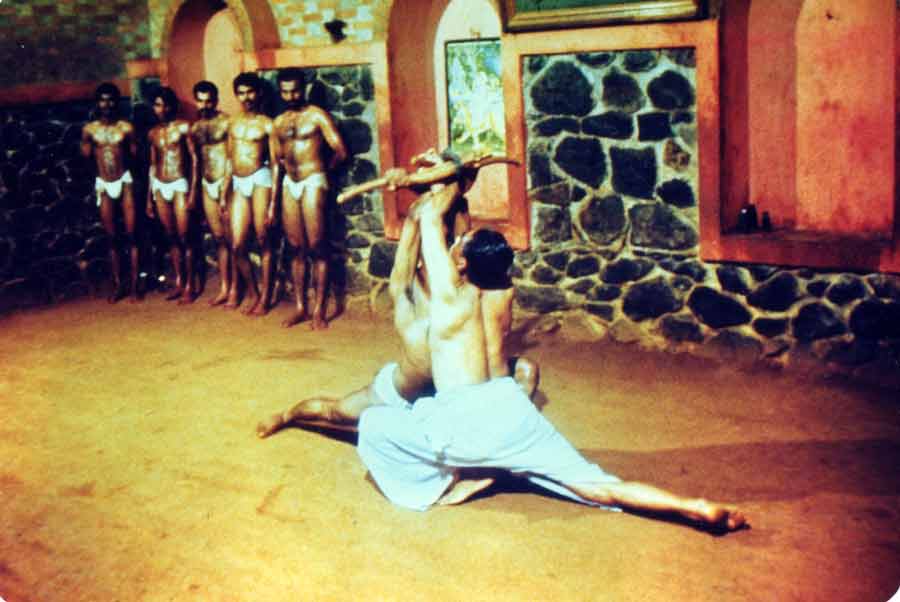
Kalari Vaidavu are whole body mudras which awaken an inner state in movement. Photo @courtesy of G. Sathya Narayan
A personal journey...
All is quiet inside the Kalari practice space. I enter the space slowly, first touching the red clay and then my heart as sign of respect. My teacher’s
voice echoes in my mind, “When you enter the Kalari, leave everything behind.” I head to the Puttara, the main altar, to center myself and make an inner
offering.
A few students and my teacher are practicing around me, swinging their legs in the preparatory sequence of flowing kicks. Kalari is humbling. You must be
able to maintain a steady gaze with your teacher while your sticks meet in an unbroken fluid flow.
There is an unspoken sharing of this sacred space and practice of Kalarippayatu as we move in silence, punctuated by occasional corrections in the lyrical
language of Malayalam. Sweat pours from our oiled bodies as we begin to experience inner and outer transformation. Even though we face a wall of ancient
weapons – sticks, swords, clubs and shields, there is an environment of inner power, respect and balance for all from the young beginners to the advanced
practitioners. Everyone maintains the Shakti of this sacred space in the embodiment of shariram bhavam – the inner energy of Kalari.
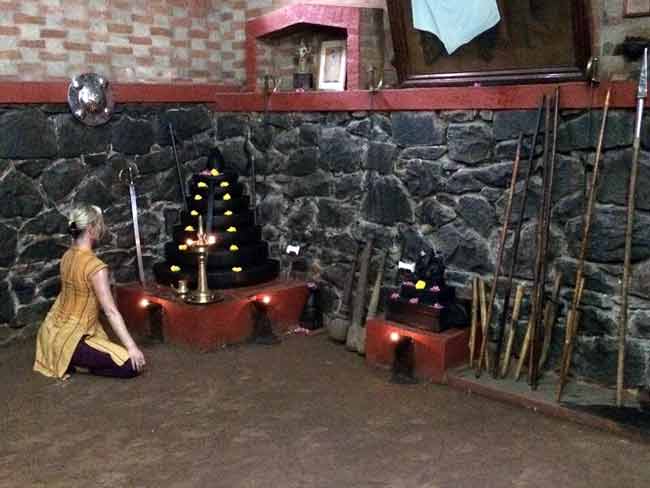
The heart of the sacred space - the Puttara (Shiva-Shakti Altar of seven steps), Nagaraga (serpent altar), weapons and
Sri Ganapati (Ganesha) altar in the southwest corner of CVN Kalari. Photo @courtesy of Shiva Rea
Kalari is the name of the consecrated temple and the short name for the practice of Kalarippayatu – one of the oldest Indian embodied art forms.
Kalarippayatu (kah-lah-ree-pay-yah-too) is often referred to as a martial art for its system of weapon practice, and has been taught for thousands of years
in Kerala, India, tracing its lineage to Paramasura – the legendary divine leader from whom the twenty-one teachers of Kalari descended, even Drona of the
mythic Mahabharata.
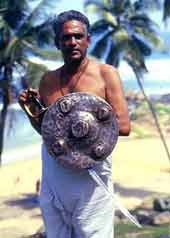
Gurukkal Govindakutty Nayar
in Kalari practice.
Photo @courtesy of
G. Sathya Narayan
Kalari literally means “a place of learning.” In Malayam culture, the place for learning Kathakali dance is a Kathakali Kalari. Kalarippayatu is the “place
of ppayatu” or “personal refinement through the successive stages of learning.” Traditionally, Kalarippayatu served as basic training for everyone in the
village; young men and women trained in the Kalari not as a martial art but as a meyyabhayasam or “body art.”
Eleven years ago Gurukkal Govindankutty Nayar initiated me, one of only a few female American students, in this living tradition of body arts at CVN
Kalari, one of the primary schools for Kalarippayatu. Six years ago, he passed away. Now his son, Sathyan Narayan, is the living representation of all
past Kalari gurus in the lineage, signifying this in the plural, Gurukkal.
Sathyan carries the lineage, including the healing arts of Kalarippayatu that are rooted in massage and marma and Ayurveda. He sees over thirty patients a
week and lives with his family in the Kalari complex. My other close teacher, Rajashekaran Nair, is a government specialist by day and Kalari Guru by
morning. Traditional in their roots, they are also cosmopolitan, having traveled the world to teach: theater with Peter Brook in France, a Jackie Chan
movie in Shanghai, and representing Kerala culture in Germany, the UK and the US. They both entered the Kalari as teenagers.
Kalarippayatu first entered my body when I learned about the practice as a freshman in the World Arts and Culture program at the UCLA. Visiting Professor
Philip Zarilli offered a workshop based on his book, When the Body Becomes All Eyes, which I highly recommend. I was inspired by the root power
and fluidity of the movements before I finally became an initiated student.
Gurkkal Sathya Narayan. Photo @courtesy of G. Sathya Narayan
Pilgrimage to the Kalari
Thiruvanathapuram, the capital city of Kerala, is an hour and a half drive north of the southern tip of India, and is marked by the Kannya Kumari temple
made of a body part of the Goddess. Kerala is Shakti Peeths is a temple made of a body part of the Goddess. Kerala is Shakti country, with many temples
dedicated to Devi, and in the rasa of the land and the the energy of the people. From the air, you see only coconut trees all the way to the horizon. The
only building is the rooftop of the famous Padmanabhaswamy Temple pushing up through the trees.
No matter the time of day or night I arrive nor how much jet lag I am experiencing, I am always ready to make the early morning pilgrimage to Kalari. My
cells come alive as I massage myself with sesame-based oils before dressing as I would for an Indian dance class in Yoga clothes covered by an Indian
kurtha shirt. The men in the Kalari wear the traditional lunghi cloth.
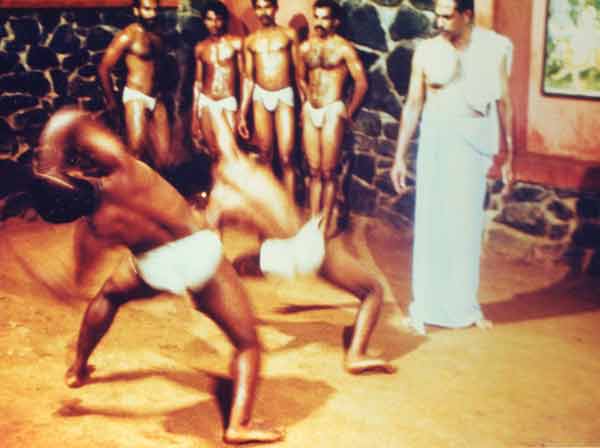
Inside CVN Kalari, practitioners apply sesame oil massage before practice to flow like a river in their movements.
Photo @courtesy of G. Sathya Narayan
As I travel through the village at 6:00 A.M., the ritual life of Kerala is stirring: People sweep the entryways of their homes and businesses or enter one
of the numerous temples. My first morning stop is to purchase flower garlands to offer in tribute to the altar’s photo of my late initiatory teacher,
Gurukkal Govindankutty Nayar.
After entering the gates of the East Fort through the bustling center of Thiruvananthapuram, the fort-like stone building of CVN Kalari comes into view. On
my right, I pass stairs winding to the observational balcony where the uninitiated can watch or even film the practice. On my left is the clinic, busy
throughout the day, where people of all ages and backgrounds receive treatments for various musculoskeletal problems.
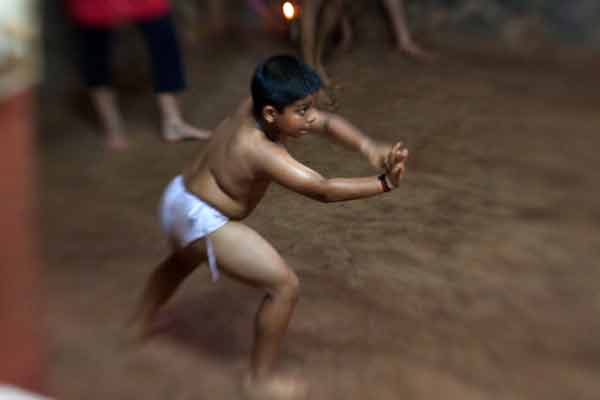
Kalarippayatu is for all ages and both girls and boys and begins from age 9 onwards.
Photo @courtesy of Shiva Rea
Entering the Kalari: The Power of Ritual Space
As my bare feet touch the red clay floor of the Kalari, I feel the throb of Bhumi Shakti, the pulsating energy of the Earth. Imagine opening the
door to the practice room in your local studio to find, not a wood floor, but the raw earth and activated altars in all corners, designed through sacred
geometry.
We initiates enter with choreographed ritual and reverence, facing East, leading with a pause of the right foot, then the right hand touching the Earth.
Appearing as casual moment of respect, this gesture can also instigate a powerful shift in consciousness. I have been moved to spontaneous prayer through
this ritual process. When I begin my home Kalari practice, no matter where I am in the world, I visualize the energy of the sacred space and touch the
Earth in the same way, and when possible, face East, as is done in the Kalari. Creating ritual space is a powerful way to generate energy, with the
greatest expression being pilgrimage sites such as the Devi temple of Kamakhya or the Samadhi of Ramana Maharishi.
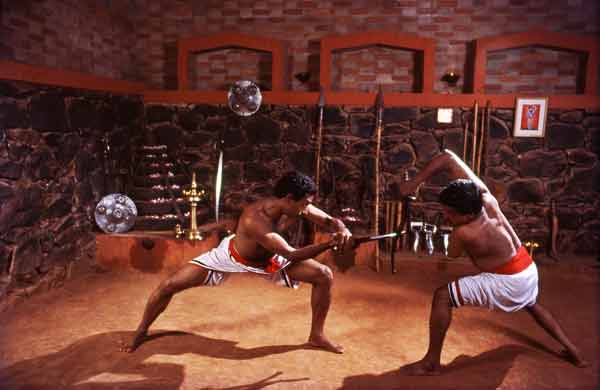
Weapons practice with the Otta, curved wooden sword with G. Sathya Narayan and Rajan Nair.
Photo @courtesy of Shiva Rea
Shiva-Shakti, Nagabhagavati and Durga’s Weapons
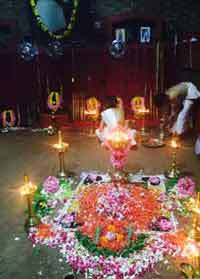
Blessing of the Kalari during
Navaratri, the nine nights for the mother.
Photo @courtesy of Shiva Rea
After touching and honoring the Earth, the next ritual involves connecting to the altars. I pray in front of the large oil lamp illuminating the Puttara –
the special seven-tiered stone altar at the heart of all Kalaris. Its place in the Southwest corner is chosen based on the principles of Vaastu Shastra,
the sacred arrangement of space guiding all Kalari temples. Before the altar representing the union of Shiva and Shakti, Bhairava and Bhairavi, gurus make
daily offerings of flowers and mantra; here students pray before practice.
We circumambulate the pit, paying respect to other altars, touching their bases with our right hands. Our fingers graze the stone Naga (serpent). As Raja
Nair elaborates, “Nagabhagavati is serpent goddess who wraps around Lord Shiva’s body and a protector of the land.” We pay homage to Lord Ganapati (the
remover of obstacles), the Guru Pitham (the seat of all the Gurus) who cares for all the Kalari weapons, the local protector and large devotional images of
Saraswati, Mahalakshmi and Durga. Durga, the warrior goddess with her ten arms holding eight weapons of consciousness, is a central part of the Kalari.
The final three days of the autumn goddess festival, Navaratri (occurring this month, in October) include ritual worship of all of the weapons connected
with the lineage. Throughout the year, before each practice, practitioners touch weapons to the Puttara, ritually relating to them as sacred instruments.
These rituals are part of the daily maintenance of the Kalari as a living temple through an ancient practice Iineage through the Gurukkal and the
practitioners circulating their life energy into the place and the altars through prayers. Only after this brief and potent ritual, including greeting
teachers in a respectful but low key way, does the embodied practice of Kalarippayatu begin.
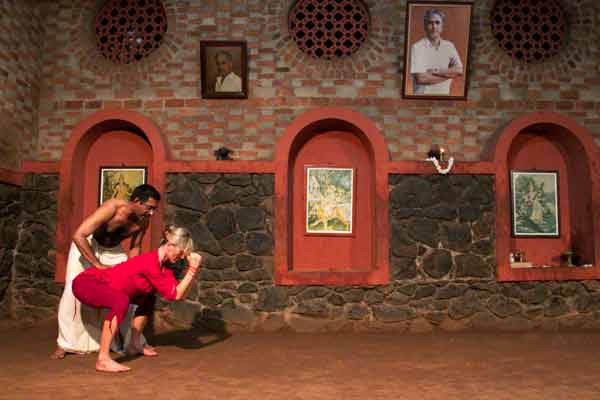
Gaja Vaidavu - the body mudra of the elephant. Photo @courtesy of Shiva Rea
Kalari Vaidavus, Posture as Whole Body Mudras
Kalari students begin their embodied practice by learning meybhasa – swinging kicks moving from the East to the West in a continuous flow emerging
and ending in vaidavus or Kalari postures. The eight kicks flow forward, to the side, around the body, turn and flow from the ground to rise and
finally spin in a flowing circular backbend.
The eight primary Kalari postures or vaidavus are named for animals that are experienced in sharira mudras or forms containing
concentrated energy that awakens the energy invoked by the particular form:
Gajavadivu
(elephant pose)
Simhavadivu
(lion)
Varahavadivu
(wild boar)
Sarpavadivu
(serpent)
and Marjaravadivu (cat)
Kukkuvadivu
(rooster)
Matsyavadivu
(fish)
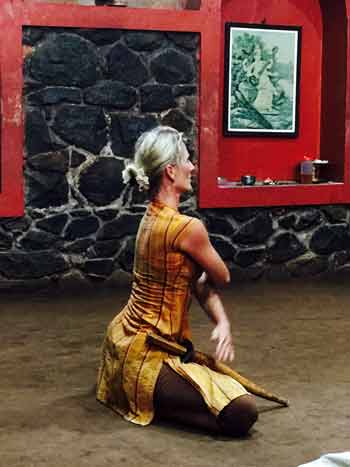
Honoring the weapons before practice.
Photo @courtesy of Shiva Rea
These sharira mudras are repeated through the practice until the abhyasi (Kalari practitioner) becomes one with vidavu of a lion
or serpent as an emanation of their embodied spirit. The inner energy comes alive, awakens and stabilizes through nabhi mula or “root of the navel
energy;” in Yoga, this is the same energy activated in uddiyana bandha.
“Nabhi mula is the activation of samana vayu of the movement of prana” says my teacher, “that draws energy to the core to bring
balance not just to the body but inner mind. This is the importance of foot work and the preliminary leg exercises for they help a person find their
internal center through their external body. A person balances within the flow by sensing how they can move in the space with the least amount of effort
and the maximum flow while all the time keeping the energy within their center.”
Yoga and Kalari share many similarities. For example, asvadivu (horse) has the same lower body stance as virabhadrasana one or warrior
pose. The difference is that in asvadivu, the hands rest on the inside of the inner leg. When I teach this Kalari posture (with my teacher’s
permission) in a Yoga class, I emphasize the balance of form and feeling that I learned from the way my teachers transmit the energy of the postures
through their own bodies and the methods they use to adjust the spine in relation to the feet to awaken the core flow of prana.
The Vinyasa Wave of Kalari
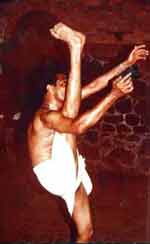
Nerkal or leg exercises
awaken the inner center
or nabhi mula as one moves
across the earthen practice space.
Photo @courtesy of
G. Sathya Narayan
The preliminary leg exercises and Kalari postures develop one’s center in a vinyasa karma (progressive sequencing) of increasing strength developing more
fluidity and a greater gathering of energy at the center. This vinyasa brings all the postures and kicks together, adding new leaps, turns and
nuances to the flowing sequences called meippayat.
The twelve meippayat are usually practiced in groups of two to five students guided by the teachers’ commands (vaithari). The commands
provide structure from which the teacher alters the rhythm and pace. Some of my greatest moment of flow have been moving with advanced students and
teachers across the flow in the namaskar that is done to connect to the main altar.
Shariam Bhavam – The Awakened Body of Kalari
In full unbroken flow, in the rhythm to my teacher’s guidance, there is the experience of olukku, or the body moving like a river without edges.
Sathyan Narayan describes this creation of unbroken flow as the aim of Kalari movement. He views tensions of the body-mind as the blocks that create jagged
movement and the practice as a way of dissolving blockages, along with living an Ayurvedic lifestyle and the annual three to fourteen days of flowing
massage with special oils that every Kalari students traditionally receives from their teacher. The aim is to create a fluid, strong, subtle embodiment
awakened and aligned with the flow of Shakti.
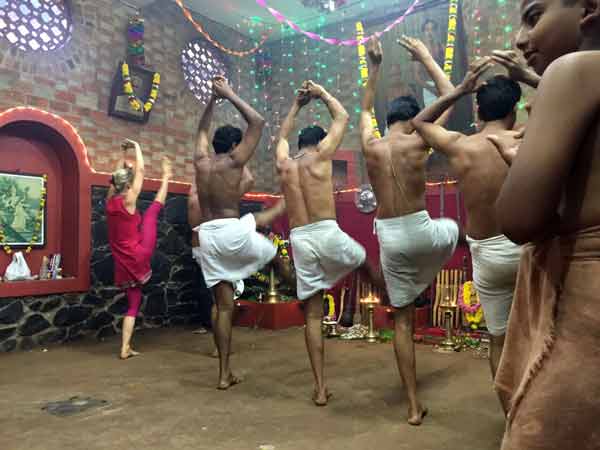
Puttara Vandanam - the flowing namaskar of Kalaripayatu. Photo @courtesy of Shiva Rea
The raw power and connection to Shakti is not spoken of directly, but it emanates, visually and viscerally, from the space and the movement. The power of
Kalarippayat comes from its intention as a method of realization and integration through the body. The intention of a Kalari practitioner is the same
orientation with serious students and master of Indian classical music, dance or sculpture. Their dedication, practice and love of their art becomes a
pathway or yoga towards the divine integration. Whatever you pour your heart into, can become a vehicle for realization.
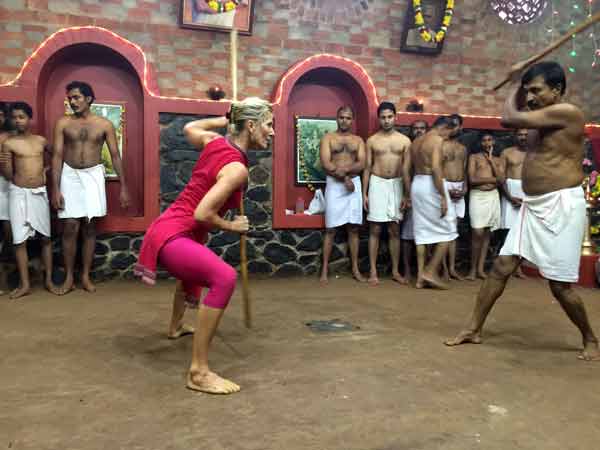
Weapons practice is a awakening of primal shakti. Photo @courtesy of Shiva Rea
Yoga of Kalari
Gurukaal Sathyan Narayan sees Yoga as part of the later, sannyasin, stages of life, where one begins to withdraw from the responsibilities of the
world to turn fully towards self-integration. He was interested in practicing Yoga as a youth but his father assured him that he would find the Yoga within
Kalari, and that “the householder phase of life requires a practice that can help a person stay balanced in the world.”
This relates to Kalari as a meyyabhayasam or body art meant as a system of refinement. It is why I study Kalari as an embodied art form and as
part of my Yoga practice. I feel a circular connection from the sacred space of the Kalari temple to my body that awakens, generates, channels and aligns
my inner energy with the Pranashakti, the greater current of life, connecting to the root traditions, the underlying power of life flowing through
all of us. When watching my teachers move, I see the Yoga of Kalarippayatu which I can feel awakening within myself. They model, naturally and with
humility, the regal essence of vira bhav – the potency of a warrior in servant to life.
The raw earth of the Kalari and the Shakti altars from the Puttara to the Nagas and Devi images and the Kalari form a place to awaken and realize the flow
of life-energy consciousness (Shiva) and energy (Shakti) embodied as one. On my altar, next to the pinch of earth from the procession of Kumbha Mela Sadhus
and Sadhvis, there is a small amount of CVN Kalari red earth to maintain the presence of the Kalari. This connection to the living power of CVN Kalari
lives on in my heart and pulls me like a magnet back home every year.
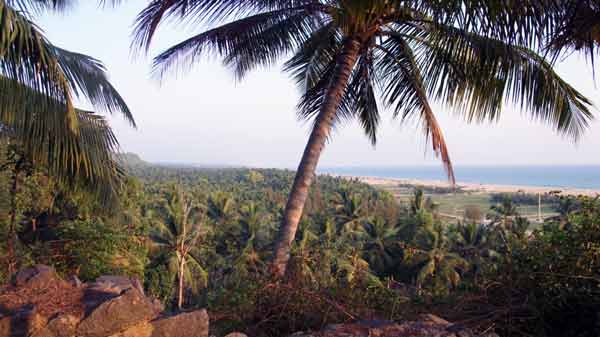
Kerala. Photo @courtesy of Shiva Rea